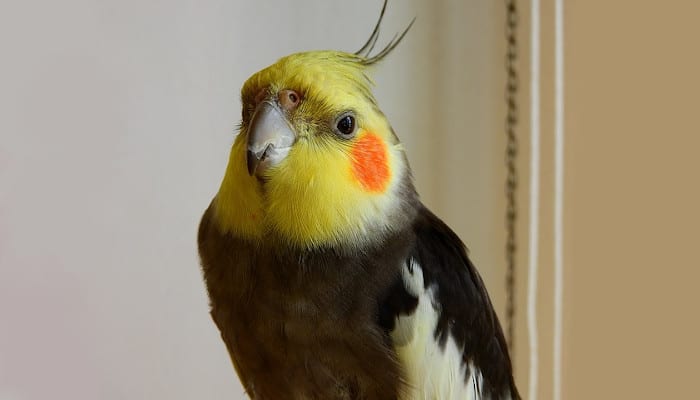It’s quite common knowledge that many animals are color blind, like dogs for example. But what about cockatiels? Are cockatiels color blind? No, cockatiels are not color blind. On the contrary – their color perception is even better than that of humans. I will explain all in this article.
Humans can see three primary colors
Cockatiels might be tiny compared to humans, but they can see different colors much better than we can. The part of the eye (in both humans and birds) that allows the perception of color is called a “cone”. Cones are a special type of photoreceptor cell and they are located in the retina.
Human eyes are “trichromatic” which simply means we have three different types of cone: Green, blue, and red. These three different types of cone enable us to see all combinations of these three primary colors. Example, we can see the color yellow thanks to the combined effort of the red and green cones.
Cockatiels can see four primary colors
In addition to the three types of cones for green, blue and red, cockatiels also have a fourth type of cone that can see ultra-violet color. Eyes that have these four types of cone are called “tetrachromatic”. It’s not just cockatiels who can see ultra-violet – Many other species of birds as well as fish and reptiles can also do so.
This fourth type of cone means that cockatiels can see in four primary colors. That fourth primary color also adds many more combinations to the palette of colors that birds can see.
Cockatiels see colors that we don’t
What is interesting is that there are lots of things that are colored with ultra-violet that we humans do not see. Many birds’ feathers are made up of ultra-violet. Birds can see all those different colors but we can’t.
There are some species of birds where the male and female look the same color to the human eye. But in fact, the male and female are totally different colors due to the ultra-violet element. We can’t see the difference, but birds can. That is how they find their mates and fight off competing males.
So coming back to the original question – Compared to cockatiels, it’s humans who are in fact color blind!
The importance of UV light in the wild
There are a few reasons why ultra-violet and how birds can see it is so important:
Foraging
In the wild, cockatiels feed on berries and insects on or close to the ground. Many of these berries and insects contain ultra-violet colors which make them highly visible to the birds. Consequently, they can feed easily and quickly which makes them less vulnerable to attack from predators.
Feathers
As mentioned above, many birds’ feathers contain ultra-violet markings and colors that only they can see. An example is the blue tit – The male has a very colorful UV crest that only birds can see. To humans, it’s not noticeable. These UV markings assist the birds in finding a mate, defending a particular territory and to differentiate an individual bird from others.
Birds of prey
Birds of prey use their ultra-violet vision to help them track mice and other rodents. The urine from rodents and mice contains UV color. From high in the sky, the birds of prey see can therefore easily see these trails of urine and follow the trails to find and kill the prey itself.
Eggs
Ultra-violet markings on eggs make it easy for birds to know which eggs are theirs and which eggs belong to another bird.
Cockatiels need UV light
Ultra violet light is produced naturally by the sun. There 3 components of UV light:
- UVA is the type of UV light that birds can see but humans can’t.
- UVB enables birds to produce vitamin D, necessary for the metabolism of calcium and for the immune function.
- UVC – is in fact absorbed by the ozone layer and isn’t present in the earth’s atmosphere. We can ignore it
Cockatiels in the wild are outside and so are exposed to natural sunlight which contains all the UVA and UVB that they need.
The problem is for cockatiels that live in a cage indoors. – If they are in a room with a window and lots of natural light, then they are getting the UVA that they need. But if there is no window or the window is small, then the cockatiel will not be getting enough UVA and his world won’t be very colorful. That can lead to a very sad bird.
For UVB – Unfortunately, it is blocked by glass, so even if there is a window, the UVB doesn’t pass through it, the birds will be unable to produce vitamin D and his health will suffer.
The solution is to buy a UV lamp for your bird and to plug it in for a few hours per day. UV lamps will provide the UVB light that your bird needs as well as an extra boost in the UVA levels which will also help the bird’s mood.








AWSOME!